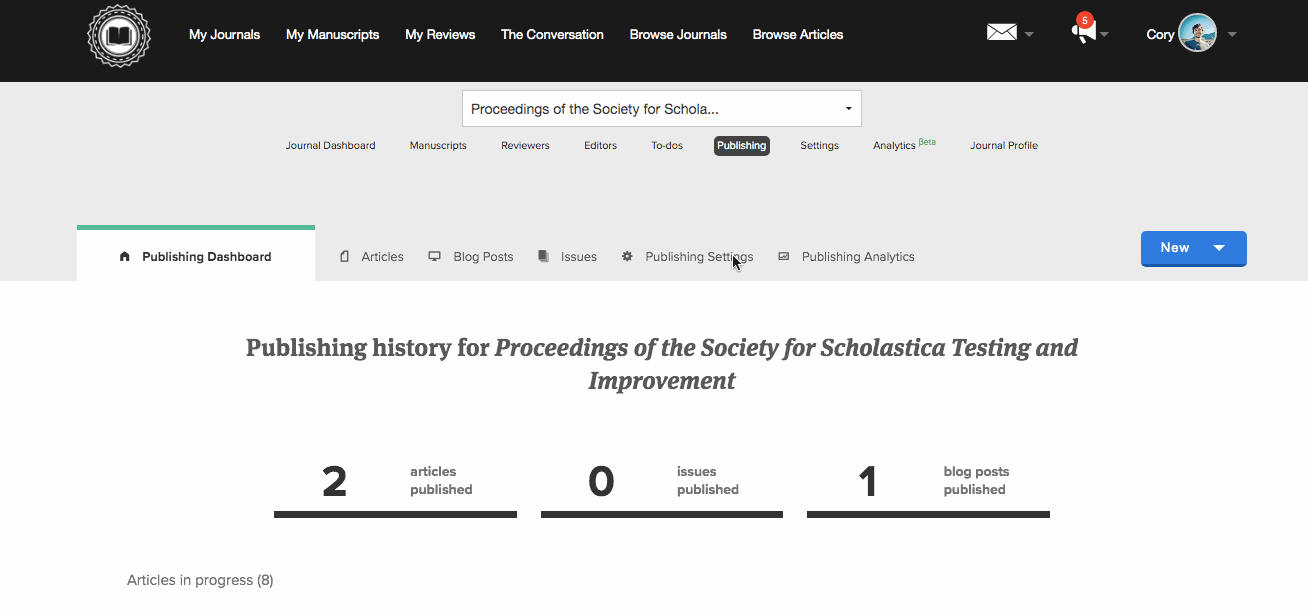
Is it possible for the journals you work with to receive submissions from scholars funded by cOAlition S member organizations?
If so, now’s the time to ensure those titles meet the latest Plan S criteria so you don’t miss out on the opportunity to publish affected manuscripts. Journals that wish to comply with the initiative to make all research funded by cOAlition S members fully and immediately Open Access (OA) have three routes to choose from:
- Open Access publishing venues: Publishing fully OA journals or hosting articles on fully OA platforms
- Subscription venues: Enabling authors to make either their published article or the Author’s Accepted Manuscript openly available in a repository without embargo (in line with the Rights Retention Strategy)
- Transition of subscription venues: Entering into transformative arrangements to make all journals fully OA via either transformative agreements or by publishing transformative journals
Quick PSA: At Scholastica, we’d add that even if you don’t think your journals are currently impacted by Plan S, reviewing and implementing the technical guidelines is still a good idea. The mandatory and strongly recommended criteria listed here are publishing best practices all digital journals should fulfill to remain relevant and competitive, regardless of their access model.
Scholastica is working to help journals comply with Plan S and meet the current digital publishing standards it encompasses. Since Plan S launched in January 2021, we’ve introduced various features to help journals using the Scholastica Peer Review System, single-source Production Service, and Open Access Publishing Platform fulfill the criteria.
In this blog post, we overview the steps journals using Scholastica’s software and services should take to be Plan S compliant in 2024.
Note: We will update this post as we introduce new improvements to Scholastica and as any changes to Plan S are released. This post was last updated on the 23rd of April 2024.
Set a Creative Commons copyright license for all articles

Let’s start with how to address one of the most fundamental Plan S requirements for the fully OA publishing route — applying open copyright licenses to all journal articles. Fully OA articles must be made openly available upon publication under a CC BY 4.0 Creative Commons Attribution license or, as secondary alternatives, a CC BY-SA 4.0 license or CC0 public domain dedication. cOAlition S members may also approve the use of the CC BY-ND license for individual articles on a case-by-case basis. Copyright licenses must be displayed on all journal articles and included in article-level metadata.
Journals that use the Scholastica OA Publishing Platform can meet the Plan S copyright requirements in a few clicks by setting a default Creative Commons copyright license for all of their articles. Journal teams can also select different CC copyright licenses for individual articles as needed via the copyright field in the article creation form. Once applied, copyright licenses will automatically be displayed on all article pages and included in the article-level metadata Scholastica generates.
To set a default copyright license for all of your articles, follow the steps in this help doc.
Apply for inclusion in the Directory of Open Access Journals and turn on automated metadata deposits

Another core Plan S requirement for journals taking a fully OA publishing route is inclusion in the Directory of Open Access Journals (DOAJ) index. DOAJ indexing serves as a mark of journal quality to scholars, their institutions, and research funders. In addition to being a Plan S requirement, DOAJ indexing can also help expand the reach and impact of articles because the DOAJ has a popular search tool, and its metadata cascades to many leading discovery services.
We cover everything you need to know about the DOAJ’s indexing criteria and how to apply for inclusion (which is free for any journal) in this blog post. Journals that use the Scholastica OA Publishing Platform will already fulfill many of the technical specifications on the DOAJ application form.
Once your journal is admitted into the DOAJ, adding articles to the index is easy with Scholastica. We offer automated metadata deposits to the index for all journals using the Scholastica OA Publishing Platform. To turn on Scholastica’s DOAJ integration, follow the steps in this help guide.
Set up DOI registration and metadata deposits for all articles

Plan S also requires journals to have Persistent Identifiers (PIDs) for all articles and states that Digital Object Identifiers (DOIs) are preferable. You can obtain DOIs from any DOI registration agency, with the most commonly used option for scholarly publishers being Crossref, a not-for-profit membership organization.
Journal publishers using the Scholastica OA Publishing Platform that are Crossref members can enable the Crossref integration option to automate DOI registration and metadata deposits via that service. Our software will automatically register DOIs under your Crossref prefix and submit rich machine-readable metadata to Crossref for all the articles you publish via Scholastica with no steps on your part.
In addition to the ability to register DOIs, Crossref offers publishers many benefits by making their research outputs easy to find, cite, link, and assess. Check out our webinar on harnessing the journal discovery benefits of Crossref content registration to learn more.
Set up long-term archiving

One of the most critical steps journals should take to ensure readers will always have access to their content, which Plan S requires, is depositing all articles into a long-term digital archive or repository. The Plan S technical guidelines state that journal publishers must deposit all their articles into a long-term preservation service such as Portico, LOCKSS, CLOCKSS, or an equivalent.
If you use the Scholastica OA Publishing Platform and you have a Portico account, you can initiate automatic article deposits to that archive. Follow the steps here to set up a Portico integration.
If you’re using CLOCKSS, Scholastica is looking for beta partners to build a CLOCKSS integration. To learn more, please email us at support@scholasticahq.com.
Add necessary peer review policies and stats details to your website
In addition to the above technical criteria, Plan S requires journals to have established peer review policies in adherence with the standards of their discipline and the Committee on Publication Ethics (COPE) guidelines, including details like the type of peer review the journal conducts (i.e., double-anonymized or single-anonymized) and the typical length of time for peer review. We outline the primary elements to include in journal peer review policies in this blog post. Journals must clearly state their peer review policies on their publication website.
The revised Plan S guidelines also require journals to publish editorial statistics at least once annually, including the number of submissions received, the number of reviews requested, the number of reviews received, the approval rate, and the average time between submission and publication.
Journals using the Scholastica Peer Review System can access the above stats from their Reviewers Table and Journal Analytics Page. Scholastica account administrators can also pull their journal’s raw data as a series of .csv files to create their own reports. Learn more in this help document.
Journals using the Scholastica OA Publishing Platform can then add sections detailing their peer review policies and peer review stats to their For Authors page or create a custom page for journal policies if more space is needed.
Provide transparent pricing information
Additionally, to be Plan S compliant, publishers must publicly state any OA journal publication fees they charge and the costs/factors impacting those fees on their website.
Per the latest Plan S Price Transparency requirements, publishers that have journals with OA publishing fees (i.e., not Diamond OA) must also submit annual pricing data to cOAlition S via the Journal Comparison Service (JCS) using one of the approved data collection templates listed here.
Journals using Scholastica’s Peer Review System can access required peer review stats for JCS uploads (e.g., acceptance rate) from their Journal Analytics Page and by exporting their raw peer review data to calculate additional metrics as needed, following the steps in this help document. Publishers can find all Scholastica pricing information needed for software/service cost reporting on our Pricing page.
Currently, price breakdowns are expected at the publisher level as a minimum, but journal-level price details are encouraged. Plan S is not enforcing any pricing caps at this time. However, the requirements clearly state that pricing should be “fair and reasonable” and that “when OA publication fees are applied, they must be commensurate with the publication services delivered.”
Have a policy for processing fee waivers (if applicable)
Plan S also requires journals with submission or publication charges to offer fee waivers for authors from lower and middle-income economies, as well as waivers and discounts for authors with demonstrable needs. Waiver policies should be clearly stated on the journal website. Journals using the Scholastica OA Publishing Platform can add a fee waiver policy to their “For Authors” page using the easy website editor tool.
Journals using the Scholastica Peer Review System also have the option to integrate with RightsLink, Copyright Clearance Center’s (CCC) OA publication payment workflow solution, to easily manage OA charges. With the integration, publishers who use RightsLink can seamlessly initiate payment for OA journal article processing charges through Scholastica when article acceptance decisions are made. We are also building out Scholastica’s metadata support to enable publishers to leverage the broad range of transformative agreement workflows and author discount calculation functionality that RightsLink offers. RightsLink can apply author fee waivers, discounts, or institutional agreements that publishers specify on an article-by-article basis.
Publishers using the Scholastica Peer Review System for their journals can quickly and easily integrate with RightsLink by following the steps in this help document.
Add funder information to published articles

Journals must also add funder information to the metadata of all articles financially supported by cOAlition S member organizations to be Plan S compliant. The implementation guidelines state that journal metadata must include “complete and reliable information on funding […] including as a minimum the name of the funder and the grant number/identifier.” It’s worth noting that adding funder metadata to articles is a general publishing best practice, regardless of the funding source.
Admins of journals using the Scholastica Peer Review System can customize their submission form to include optional or required sections for funder metadata by following the steps in this help document.
Journals using the Scholastica Production Service or OA Publishing Platform can then easily add funder information to their article-level metadata from the typesetting request or OA publishing article creation forms. Those subscribed to multiple Scholastica products can import metadata from one solution to another (e.g., from the peer review submission form to the typesetting request form) to eliminate manual data entry/review steps.
We’ll take care of the technical metadata requirements
For journals using the Scholastica Production Service and/or OA Publishing Platform, as you’re taking the above steps, we’ll automatically handle many of the other technical Plan S requirements for you, including producing rich machine-readable metadata for your articles.
Per Plan S, Scholastica produces machine-readable metadata files for all articles in standard interoperable formats (JATS XML), including copyright license information, OA status, and complete funding details. HTML articles published using the Scholastica OA Publishing Platform also automatically include bibliographic metadata formatted in HTML meta tags.
Additional Plan S recommendations
Scholastica also supports “strongly recommended” technical Plan S criteria, including:
Support for PIDS: Journals using the Scholastica Peer Review System can collect author ORCID iDs, funding source information, and institutional information from their submission form by following the steps in this help document. If you have titles just using the Scholastica Production Service or OA Publishing Platform, you can also input the listed PIDs into the typesetting request or article upload form.
To help journals collect correct and complete PID metadata, the Scholastica Peer Review System also includes ORCID iD field validation and authentication for the corresponding author. Additionally, we recently integrated the Scholastica Peer Review System, Production Service, and OA Publishing Platform with ROR institutional identifiers. So Scholastica automatically applies ROR IDs for institutions when authors input institution names into our peer review submission form and when editors add institutions to any articles sent to Scholastica’s production service or published via our OA hosting platform.
Full-text JATS XML article files: Scholastica’s digital-first production service generates full-text JATS XML for articles straight from original manuscript files with no pre-formatting or validation steps on the part of editors. Journals using the Scholastica Production Service and OA Publishing Platform also feature a full-text XML file download option on article pages.
Additionally, we now support JATS XML deposit integrations to external hosting providers as needed, including the Silverchair Platform.
Openly accessible data on citations: Scholastica automatically includes open, machine-readable citations in line with the Initiative for Open Citations (I4OC) in the JATS XML metadata we produce for journals using our production service and/or OA publishing platform.
Stay tuned for further updates
Scholastica is monitoring the Plan S guidelines, and we will continue taking steps to support our journal users in fulfilling any additional criteria or recommendations announced. To learn more, visit our Product Roadmap: Plan S, Core Open Access Publishing Standards & Scholastica. If you have any questions about the Plan S criteria or how to comply, don’t hesitate to contact us — we’re here to help!
Update Note: This post was originally published on the 9th of July 2019 and updated on the 23rd of April 2024.








